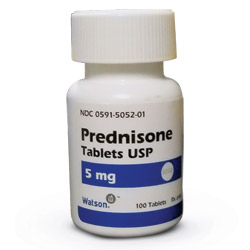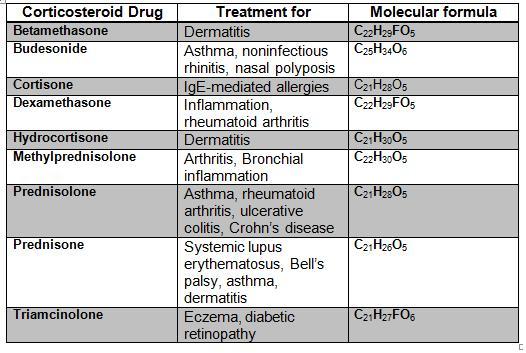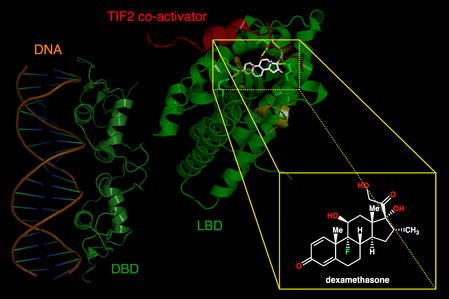Corticosteroid Medication
Original Editor - Your name will be added here if you created the original content for this page.
Top Contributors - Lucinda hampton and Kim Jackson
Introduction[edit | edit source]
Corticosteroids are synthetic analogs of the natural steroid hormones produced by the adrenal cortex and include glucocorticoids and mineralocorticoids. The synthetic hormones have varying degrees of glucocorticoid and mineralocorticoid properties. Glucocorticoids are predominantly involved in metabolism and have immunosuppressive, anti-inflammatory, and vasoconstrictive effects.[1]
Corticosteroid drugs (including cortisone, hydrocortisone and prednisone) are useful in treating many conditions, such as rashes, inflammatory bowel disease and asthma. However these drugs also carry a risk of various side effects.[2]
- Corticosteroids are among the most widely prescribed drug classes worldwide, with an estimated market of more than 10 billion USD per year.
- These medicines are on the WHO list of essential medicines, meaning they are widely available (usually at low cost).[3]
The 9 minute video below gives a good overview
Indications[edit | edit source]
Common indications for corticosteroids, by field, include:
- Allergy and Pulmonology: asthma exacerbation, COPD exacerbation, anaphylaxis, urticaria and angioedema, rhinitis, pneumonitis, sarcoidosis, interstitial lung disease.
- Dermatology: contact dermatitis, pemphigus vulgaris
- Endocrinology: adrenal insufficiency, congenital adrenal hyperplasia
- Gastroenterology: inflammatory bowel disease, autoimmune hepatitis
- Hematology: hemolytic Anaemia, leukemia, lymphoma, idiopathic thrombocytopenic purpura
- Rheumatology: rheumatoid arthritis, systemic lupus erythematosus, polymyositis, dermatomyositis, polymyalgia rheumatica
- Ophthalmology: uveitis, keratoconjunctivitis
- Other: organ transplantation, antenatal lung maturation, nephrotic syndrome, cerebral edema, multiple sclerosis.
- Corticosteroids with very little mineralocorticoid effect (ie little fluid retention) are used for conditions were fluid retention and oedema want to be kept to a minimum. Conditions include: HACE (high altitude cerebral oedema); Spinal Cord Injury ( within 8 hours); Bacterial Meningitis.
Route of Administration[edit | edit source]
The route of administration for corticosteroids depends on many factors, primarily being the disorder treated. The route can be parenteral, oral, inhaled, topical, injected (intramuscular, intraarticular, intralesional, intradermal, etc.), and rectal. [1]
Mechanism of Action[edit | edit source]
Corticosteroids produce their effect through multiple pathways. They produce: anti-inflammatory and immunosuppressive effects; protein and carbohydrate metabolic effects; water and electrolyte effects; central nervous system effects; and blood cell effects.
They act by binding to intracellular receptors which then act to modulate gene transcription in target tissues. The pathophysiology of corticosteroid action has recently been illuminated by genetic analysis of congenital deficiency syndromes and by producing 'knockout' mice with gene deficiencies for glucocorticoid or mineralocorticoid receptors.[5]
Side Effects[edit | edit source]
Despite their significant efficacy, their many adverse effects limit the utility of corticosteroids. Corticosteroid adverse effects appear to be related to both their average dose and cumulative duration. Adverse effects are more common at higher dosages and with chronic use though they are not limited to these cases. Adverse effects are seen in up to 90% of patients who take them for more than sixty days.[1]
- Short term use has few side effects.eg steroid injections, a steroid inhaler, short course of steroid tablets.
- Prolonged treatment at high doses – particularly with steroid tablets – cause side effects in some people.[6] The most common adverse effects of corticosteroids include osteoporosis and fractures, suppression of the hypothalamic-pituitary-adrenal (HPA) axis, Cushingoid features, diabetes and hyperglycemia, myopathy, glaucoma and cataracts, psychiatric disturbances, immunosuppression, cardiovascular disease, gastrointestinal and dermatologic adverse effects[1].
Physiotherapy Implications[edit | edit source]
All interprofessional healthcare team members should be ready to educate their patients on corticosteroids and their potential adverse effects, and the modifications that can reduce these harmful effects.
- Osteoporosis; A 2013 systematic review reporting that to to manage osteoporosis clients "may benefit from an exercise program at least 2 to 3 times per week over the course of at least 6 months, and physical therapists should consider helping their clients and patients to plan and design appropriate programs" The types of exercises recommended were high-force, non–weight-bearing exercise, such as progressive resistance training of the lower extremity, strength training and walking.[7]
- Weight Gain: educate re healthy diet and advocate regularly exercising to try to prevent excessive weight gain.
- Muscle wasting: starting a strengthening home exercise program to strengthen the major muscle groups would be ideal. The best exercise program would be one that benefited the bones, muscles and blood pressure.
- Fluid Retention: educate re swelling of ankles, and provide foot and ankle exercises and if appropriate compression stockings. Blood pressure should be checked regularly, especially if a history of hypertension exists. Dr may need to prescribe diuretics or other medications to manage these problems.
- Their doctor should be monitoring for the side effects including high cholesterol, BP, blood sugars etc.
Conclusion[edit | edit source]
Corticosteroids (cortisone-like medicines) are used to provide relief for inflammatory conditions. Corticosteroids are very strong medicines. In addition to their helpful effects in treating medical problem, they have side effects that can be very serious. Take note if clients are on these medications and take appropriate precautions with treatment eg osteoporotic bones, fragile skin. Note any adverse effects and notify appropriate medical staff.
References[edit | edit source]
- ↑ 1.0 1.1 1.2 1.3 Hodgens A, Sharman T. Corticosteroids. StatPearls [Internet]. 2020 Feb 14.Available: https://www.ncbi.nlm.nih.gov/books/NBK554612/#!po=9.37500(accessed 8.6.2021)
- ↑ Mayo clinic Available: Prednisone and other corticosteroidshttps://www.mayoclinic.org/steroids/art-20045692 (accessed 29.9.2022)
- ↑ The conversation The evidence is in. WHO says corticosteroids really do save lives of people critically ill with COVID-19 Available:https://theconversation.com/the-evidence-is-in-who-says-corticosteroids-really-do-save-lives-of-people-critically-ill-with-covid-19-145536 (accessed 8.6.2021)
- ↑ Instructor Gwin Corticosteroid Medication Available from: https://www.youtube.com/watch?v=aR-Z06L-F10 (last accessed 24.9.2019)
- ↑ Australian Prescriber Corticosteroids - mechanisms of action Available:https://www.nps.org.au/australian-prescriber/articles/corticosteroids-mechanisms-of-action (accessed 29.9.2022)
- ↑ IPPF Handling Prednisone’s Side Effects Naturally Available from: http://www.pemphigus.org/handling-prednisones-side-effects-naturally-2/ (last accessed 23.9.2019)
- ↑ Palombaro KM, Black JD, Buchbinder R, Jette DU. Effectiveness of exercise for managing osteoporosis in women postmenopause. Physical therapy. 2013 Aug 1;93(8):1021-5. Available from: https://academic.oup.com/ptj/article/93/8/1021/2735493 (last accessed 24.9.2019)










